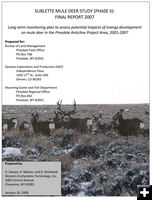Mesa mule deer population up
by Questar Market Resources press release
February 17, 2009
(Pinedale) - Today (Tuesday, February 17), Western Ecosystems Technology, Inc (WEST) released the completed Phase II Final Report of the Sublette Mule Deer Study. The study results revealed that the Mesa portion of the Sublette mule deer herd stabilized and increased during the last three years of the study.
"Questar is encouraged by this positive trend and believes that recent mitigations such as installation of a Liquids Gathering System (LGS) and increased directional drilling have played a positive role," said Diana Hoff, General Manger of the Pinedale Division for Questar Exploration and Production.
Over the first four years of the study there was a decline in the mule deer numbers, which was attributed to multiple causes, including drought, severe winters, and oil and gas activity. The last three years, however, have shown increasing winter use of the Pinedale Anticline by mule deer.
Questar provided primary funding for this study, which was designed to understand potential energy-related impacts on wintering mule deer on the Pinedale Anticline. Wyoming Game and Fish Department (WGFD) provided logistical support, in-kind donations and project consultation. The Bureau of Land Management (BLM), Ultra Resources, Inc. and Shell Exploration & Production, Co. provided additional funding support.
The study is supportive of several mitigations, such as the installation of the LGS and increased directional drilling, which were initiated by Questar during the Phase II time frame. The LGS concept was developed with Wyoming Game and Fish and was part of Questar’s 2004 Year-Round Drilling EA. The WGFD also stated during the recent Supplemental Environmental Impact Statement (SEIS) process that it supports year-round development which includes mitigations such as directional drilling, centralized gas pipelines, and piping, rather than trucking, of water and condensate.
The study demonstrated that producing well pads connected to the LGS resulted in significantly less indirect mule deer habitat loss than well pads not connected to the LGS. Directional drilling has also played a key role in reducing direct habitat loss by consolidating multiple wells on most pads.
Questar has eliminated over 52,000 tanker truck trips, along with dust and associated human activity, since installation of the LGS. This type of system will be installed across the vast majority of the Pinedale Anticline as part of the 2008 Pinedale Anticline SEIS Record of Decision (ROD) and is expected to eliminate 165,000 truck trips per year when the field is at peak production.
Diana Hoff added, "We are also pleased to see that the migration routes of the mule deer, to and from the Mesa, are intact and functional."
The study is available from the Western Ecosystems Technology, Inc. website for review here (118 page, 12MB PDF).
Please contact Emily Kelley, Sr. Communications Specialist for Questar with any further questions or for more information, 303-308-3623 (Denver, Colorado).
|
